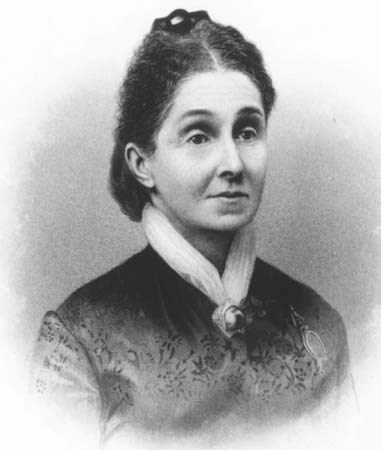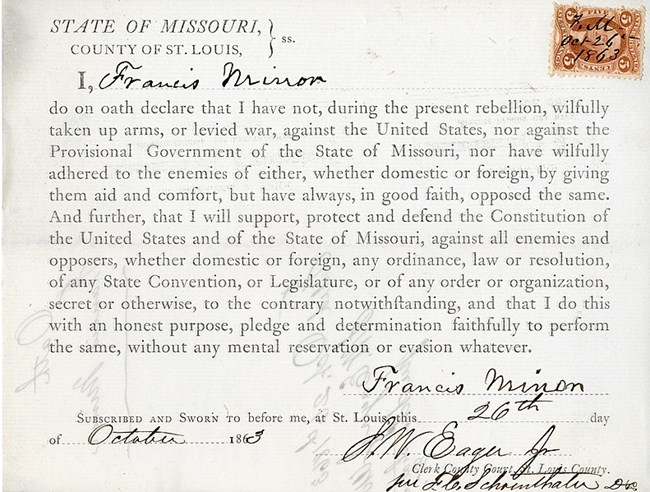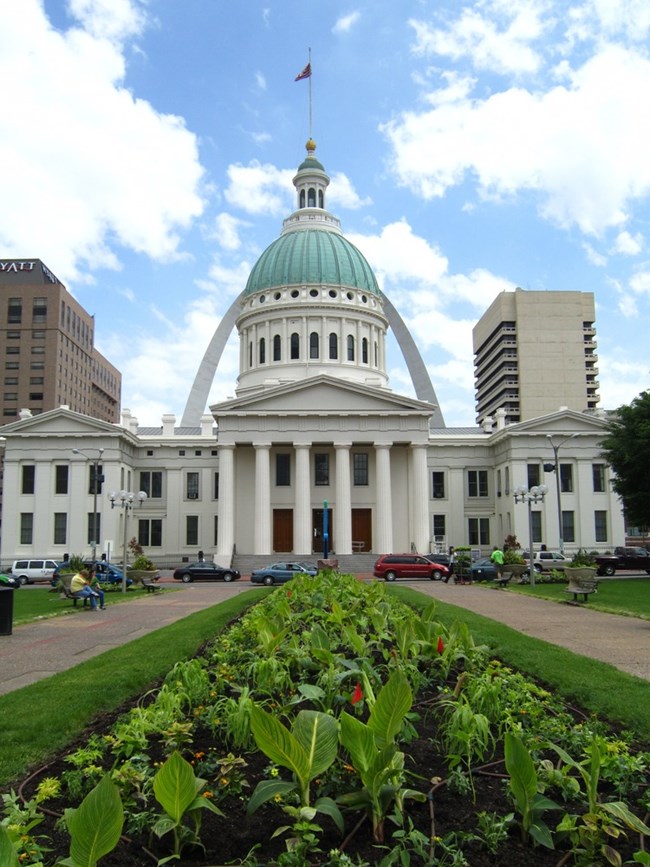Last updated: July 19, 2019
Article
Virginia Minor and Women's Right to Vote

http://loc.gov/pictures/resource/cph.3b46735/
Virginia Minor and her husband Francis moved from Virginia to Mississippi and then, in 1844 to St. Louis, Missouri to join family members who had also moved west. Just before the beginning of the Civil War, they purchased a farm in St. Louis, in what is now the Central West End. In 1866, their only child – a son – died in an accident. That same year, Virginia Minor launched the woman suffrage movement in Missouri, and in 1867 took an active role in founding the Woman Suffrage Association of Missouri. This was the first organization in the world to make its exclusive aim that of enfranchising women. She was elected the first president of this organization at their premiere meeting, held on May 8, 1867 in the Director's Room of the Mercantile Library in St. Louis. This meeting predated the National Woman's Suffrage Association, founded by Susan B. Anthony and Elizabeth Cady Stanton, and the American Women's Suffrage Association founded by Lucy Stone in 1869.
At the woman suffrage convention held in St. Louis in 1869, Virginia Minor made an impassioned speech urging women to no longer submit to their inferior condition. Francis Minor drafted a set of resolutions which asserted the right of woman suffrage under the U.S. Constitution, based on the wording of the 14th Amendment. When printed in pamphlet form, this message was sent around the country. Minor stated that under the terms of the 14th Amendment, ratified July 9, 1868, women were citizens of the United States and entitled to all the benefits and immunities of citizenship. Thus, women already, by law, had the right to vote. All they had to do was go out and exercise this right.
The Minors used the first section of the 14th Amendment to make their case. This states that "All persons born or naturalized in the United States and subject to the jurisdiction thereof, are citizens of the United States and of the State wherein they reside. No State shall make or enforce any law which shall abridge the privileges or immunities of citizens of the United States; nor shall any State deprive any person of life, liberty, or property, without due process of law; nor deny to any person within its jurisdiction the equal protection of the laws."

From the collections of the Missouri Historical Society. https://mohistory.org/collections/item/resource:192442
In 1872 it was not a new thing for a woman to vote in an election, but that was the year targeted by the NWSA for a nationwide attempt to force the issue of woman suffrage and gain headlines. For instance, several women tried to vote in the 1870 and 1871 elections in various parts of the country. Wyoming Territory granted universal suffrage in 1869, and Utah followed suit in 1870. In 1871, a Michigan woman voted successfully because voting officials did not question her rights, and she continued to vote for several years thereafter. But 1872 would be the election which provoked the test case.
On October 15, 1872, Virginia Minor tried to register to vote in the upcoming election. She was refused by St. Louis' sixth district registrar, Reese Happersett. Happersett refused to register Minor because she was a woman, thus provoking a civil suit brought by Virginia and her lawyer husband, Francis Minor. Minor's action was part of a nation-wide pattern of civil disobedience, in which hundreds of women across the country attempted to vote. Susan B. Anthony led a small delegation of women to the polls in Rochester, New York, and was successful in casting her vote for Ulysses S. Grant. Three weeks later, however, on Thanksgiving Day, Anthony was arrested on the charge of voting fraud. Anthony was a celebrity who was used by the judicial system as an example and a warning to all women in the United States. When Anthony's case came to trial early in 1873, the judge had written his opinion before the trial started, and directed the jury to find a guilty verdict.
Virginia Minor's case was different in that she was not prosecuted criminally for trying to vote, but brought suit in a civil action against the registrar who would not allow her to register to vote. Francis had to file the law suit, however, since married women could not sue in Missouri courts until after the passage of the Married Women's Act of 1889. Minor contended that women were U.S. citizens under the 14th amendment to the Constitution, which "nowhere gives [states] the power to prevent" a citizen from voting.
The Minor's petition was presented to the court as a written statement on January 2, 1873. Reese Happersett's lawyer, Smith P. Galt, objected to the Minor's version of the events and filed a demurrer and appealed to have the case heard during the General Term of the Circuit Court. This hearing took place on February 3, 1873 in Circuit Court #5, Old Courthouse Room 212. By agreement, both sides submitted their arguments in writing. There was no trial or jury in the Virginia Minor case. The Minors were represented by John B. Henderson, John M. Krum, and Francis Minor. Henderson was the author of the 13th Amendment and an agitator for the 15th Amendment to the U.S. Constitution. The Minors quickly lost their case in the lower court, but appealed to the Missouri Supreme Court.

The case was appealed to the U.S. Supreme Court, where Francis Minor made the presentation. He claimed that denial of suffrage in the states was a matter of practice rather than law. For instance, women had voted in New Jersey between 1787 and 1807 when a new state constitution made no mention of woman suffrage. Minor stated that "the plaintiff has sought by this action for the establishment of a great principle of fundamental right, applicable not only to herself but to the class to which she belongs, for the principles here laid down, (as in the Dred Scott case,) extend far beyond the limits of the particular suit and embrace the rights of millions of others, who are thus represented through her. . . . It is impossible that this can be a republican government, in which one-half the citizens thereof are forever disenfranchised."
In October 1874 the U.S. Supreme Court ruled, in a unanimous decision handed down by Chief Justice Morrison R. Waite, that "the Constitution of the United States does not confer the right of suffrage upon anyone," because suffrage was not coexistent with citizenship. The courts ducked the issue of defining a woman's place in society, and refrained from discussing the fact that although women were full citizens under the law, they did not enjoy the same rights and privileges of citizenship as men did. The courts merely upheld the right of individual states to decide which citizens could vote within their borders.
With the court's decision, hopes for a judicial solution to the woman suffrage question were dashed. Suffragists turned their efforts toward state-by-state campaigns to change state constitutions to allow women to vote. These efforts were particularly successful in the West. The territories of Wyoming and Utah already allowed women to vote, and Wyoming came into the union as a state in 1890 with no voting restrictions placed upon women in statewide elections. In 1893, Colorado allowed women the vote; in 1896, Idaho, and Utah came into the union in that year with no voting restrictions against women. The State of Washington allowed women to vote in 1910, followed by California in 1911 and Oregon, Arizona and Kansas in 1912. Several other states, including Nebraska, Delaware, Minnesota, and New Hampshire allowed women to vote in school board and/or municipal elections, provided they met other qualifications including property ownership.
Virginia Minor appeared before the U.S. Senate committee on woman suffrage in 1889 to once more state her case. She served as honorary vice president of the Interstate Woman Suffrage Convention, held in Kansas City in 1892. She died in 1894, and was buried in Bellefontaine Cemetery in St. Louis.
Like the Dred Scott case, the Virginia Minor case dealt with definitions of who is a citizen, and what privileges and immunities citizenship entails. The women's movement of the 1870s was actually a national movement for citizenship rights. It was only after the hopes of the movement were dashed with the Minor decision that it became a single-issue, women's suffrage movement. The animosities which resulted pitted one social group against another, with white women, African-American women, and African-American men often in separate camps, with little cooperation toward a goal of mutual interest. As a direct result of the denial of the right to vote to women, the courts found ways in which to limit voting rights for African-American men as well, cynically skirting the legislation of the 14th and 15th amendments with "Jim Crow" laws. These laws eventually extended beyond just voting rights to a "separate but equal" system of segregation sanctified by the Supreme Court's ruling in Plessy v. Ferguson. The U.S. Supreme Court was determined to uphold state’s rights in reaction to the expansion of the Federal Government's power during the Civil War. Individual human rights, rarely considered by the court during this period, were secondary to the preservation of the rights of individual states to regulate voting and other matters within their borders. It was only much later, in the 1950s that the court began to exercise a fundamental philosophy of human rights, hearkening back to Thomas Jefferson's idealistic "all men are created equal" phrase in the Declaration of Independence. The nation should not only preach ideals and human rights, the Earl Warren-headed court professed, but as the foremost democracy on earth it should also uniformly practice fair and equal treatment for all its citizens, in whatever state they might reside. The Voting Rights Act of 1965 prohibits racial discrimination in access to the ballot; later amendments further expand its protections. The Civil Rights Act of 1968 includes penalties for those who interfere with a person’s access to the vote.
Hear audio clips (RealAudio format) which feature a historical narrative from Virginia Minor, who recounts her attempts to win the right to vote.
To listen to the narrative, you will need to download RealAudio if it is not installed on your computer. Download RealAudio (link opens new browser window).
You can also read the narrative.
Notes
[1] The Old Courthouse in St. Louis, Missouri is part of Gateway Arch National Historic Site. It was added to the National Register of Historic Places on October 15, 1966.
Bibliography of Sources
Primary Sources:
St. Louis Times:
October 16, 1872, p. 1
November 1, 1872, p. 5
November 6, 1872, p. 4
November 13, 1872, p. 4
November 22, 1872, p. 4
January 3, 1873, p. 8.
January 22, 1873, p. 6.
January 25, 1873, p. 1.
February 23, 1873, p. 12.
February 25, 1873, p. 4.
March 6, 1873, p. 4.
May 1, 1873, p. 4.
May 8, 1873, p. 2.
St. Louis Globe:
October 2, 1872, p. 4
October 15, 1872, p. 4
October 16, 1872, p. 2
Statement, Brief and Petition in the Case of Virginia L. Minor vs. Reese Happersett, St. Louis: Industrial Age Printing Company, 1873
Post, Truman A., editor, Reports of Cases Argued and Determined in the Supreme Court of the State of Missouri, vol. LIII. St. Louis: Gilbert Book Company, 1907.
Wallace, John William, editor, Cases Argued and Adjudged in the Supreme Court of the United States, October Term, 1874, vol. XXI. Washington, D.C.: W.H. & O.H. Morrison, 1875.
Laws of Missouri Passed at the Session of the 35th General Assembly Jefferson City, Missouri: Tribune Printing Company, 1889.
Secondary Sources:
Coalier, Paula, “Beyond Sympathy: The St. Louis Ladies’ Union Aid Society and the Civil War,” Gateway Heritage, Summer 1990, Vol. 11, No. 1, pp. 38-51.
DuBois, Ellen "Speech at the Conference on the 75th Anniversary of the Women's Suffrage Movement."
Jensen, Oliver "Letter from the Editor" [About the election of 1872] American Heritage, June 1972
Lehman, Godfrey D. "Susan B. Anthony Cast Her Ballot for Ulysses S. Grant" American Heritage, December 1985
Lunardini, Christine, What Every American Should Know About Women's History, Holbrook, Massachusetts: Bob Adams, Inc. 1994
Morris, Monia Cook, “The History of Woman Suffrage in Missouri, 1867-1901,” Missouri Historical Review, October 1930, Vol. XXV, No. 1, pp. 67-82.
Whites, Lee Ann, “The Tale of Two Minors: Women’s Rights on the Border,” in Whites, Lee Ann, Mary C. Neth, and Gary R. Kremer, Women in Missouri History: In Search of Power and Influence (Columbia and London: University of Missouri Press, 2004), pp. 101-118.
